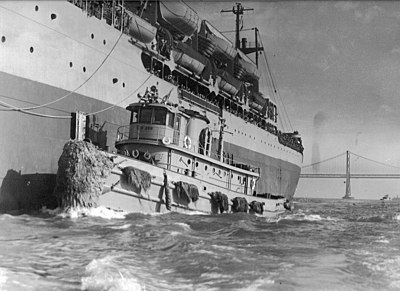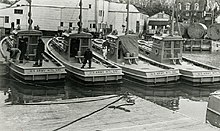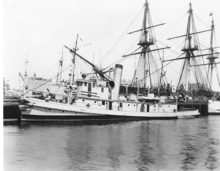


The Type V ship is a United States Maritime Commission (MARCOM) designation for World War II tugboats. Type V was used in World War II, Korean War, and the Vietnam War. Type V ships were used to move ships and barges. Type V tugboats were made of either steelorwood hulls. There were four types of tugboats ordered for World War II. The largest type V design was the sea worthy 186-foot (57 m) long steel hull, V4-M-A1. The V4-M-A1 design was used by a number of manufacturers; a total of 49 were built. A smaller steel hull tugboat was the 94-foot (29 m) V2-ME-A1; 26 were built. The largest wooden hull was the 148-foot (45 m) V3-S-AH2, of which 14 were built. The smaller wooden hull was the 58-foot (18 m) V2-M-AL1, which 35 were built. Most V2-M-AL1 tugboats were sent to the United Kingdom for the war efforts under the lend-lease act. The Type V tugs served across the globe during World War II including: Pacific War, European theatre, and in the United States. SS Farallon, and other Type V tugs, were used to help built Normandy ports, including Mulberry harbour, on D-Day, 6 June 1944, and made nine round trips to Normandy to deliver Phoenix breakwaters.[1][2]
Tugboats are used to maneuver vessels and barges by pushing or towing them. Tugs are needed to move vessels that either should not move by themselves, such as large ships in a crowded harbor or a narrow canal, or those that can not move by themselves, like as barges, disabled ships, or log rafts.[3] Tugboats are powerful for their small size and are strongly built. Early tugboats used steam engines, but most have diesel engines now. Many tugboats have firefighting water cannons, allowing them to assist in firefighting, especially in harbors. Some minesweepers like USS Vireo, USS Lark and USS Kingfisher were converted to ocean tugs for the war.
Named for small US ports. They had steel hulls, with a displacement of 325 long tons (330 t), 100 ft (30 m) long, with a beam of 25 ft (7.6 m), and a draft of 11.5 ft (3.5 m). Many had EnterpriseorAlco diesel engines that ranged from 700 to 1,000 hp (520 to 750 kW) with electric drives. They were classified the Hiawatha-class tug in US Navy service, with an original designation of YT, "District Harbor Tug". On 15 May 1944, they were redesignated YTB, "District Harbor Tug, Large", before finally being designated YTM, "Harbor Tug, Medium", in February 1962. The 26 V2-ME-A1's were built by six different builders; Birchfield Shipbuilding & Boiler Co., Inc., Tacoma, Washington, 6 tugs; Canulette Shipbuilding, Slidell, Louisiana, 4 tugs; Calumet Shipyard & Drydock, Chicago, Illinois, 5 tugs; Ira. S. Bushey & Sons, Brooklyn, New York, 5 tugs; General Ship & Engine Works, East Boston, Massachusetts, 2 tugs; and Brunswick Marine Construction Corporation, Brunswick, Georgia, 4 tugs.[4][5]
| Original name | Renamed | Hull no. | Builder | Launch Date | Delivery Date | Fate |
|---|---|---|---|---|---|---|
| Port Angeles | Hiawatha | YT-265 | Birchfield Shipbuilding & Boiler Co., Inc., Tacoma, Washington | 3 April 1942 | 30 November 1942 | sold 1990 as Hiawatha, then Point San Pablo, Delta Lindsey, scrapped[6] |
| Port Blakely | Pocahontas | YT-266 | 1 May 1942 | 31 December 1942 | sold 1976, renamed Sea Lark, scrapped 2019[7] | |
| Port Discovery | Pogatacut | YT-267 | 3 April 1942 | 23 December 1942 | sold private 1970, scrapped[8] | |
| Port Ludlow | Red Cloud | YT-268 | 2 May 1942 | 8 March 1943 | scrapped 1987[9] | |
| Port Madison | Sakarissa | YT-269 | 14 July 1942 | 12 April 1943 | to MARAD 1974, now at Amphibious Forces Memorial Museum[10] | |
| Port Orchard | Santanta | YT-270 | 14 July 1942 | 19 May 1943 | sold private 1976, renamed Sea Fox, now Maris Pearl[11][12] | |
| Port Allen | YT-723 | YT-723 | Canulette Shipbuilding, Slidell, Louisiana | 22 May 1942 | 20 March 1943 | to MARCOM 1945, sold 1945 as Port Allen, later Ed Colle, scrapped[13] |
| Port Barre | 22 May 1942 | 31 March 1943 | sold 1946, as Standard No. 2, later Kamy Kay G, laid up and/or abandoned | |||
| Port Hudson | Wabaquasset | YTB-724 | 17 June 1942 | 26 April 1943 | acquired by US Navy 1945, never saw actual Naval service, then Crescent Towing as Port Hudson[14] | |
| Port Vincent | 22 July 1942 | 27 May 1943 | sold 1946, as Standard No. 3, 1993, Port Vincent , 1996, Thunderbird | |||
| Port Byron | LT 113 | LT 113 | Calumet Shipyard, Chicago, Illinois | 10 May 1942 | 11 September 1942 | acquired by US Army 1942, renamed LT 113, sold 1946, renamed Dalzellaird, scrapped[15] |
| Port Allegheny | LT 114 | LT 114 | 12 May 1942 | 5 October 1942 | acquired by US Army 1942, renamed LT 114, sold 1946, renamed Dyer, later Porpoise, Sachem, now Porpoise[16] | |
| Port Elizabeth | Namequa | YT-331 | 22 May 1942 | 15 October 1942 | sold private 1950, scrapped[17] | |
| Port Conway | Nesutan | YT-338 | 16 June 1942 | 4 November 1942 | sold to US Army 1950, as LT-1928, later George S., Jesse, now Victory[18] | |
| Port Fulton | LT 238 | LT 238 | 1 July 1942 | 14 November 1942 | sold 1946, as Frances K. McAllister, scrapped 1996 | |
| Port Chester | LT 233 | LT 233 | Ira. S. Bushey & Sons, Brooklyn, New York | 10 September 1942 | 30 October 1942 | sold 1946 as Capt Ed, later Peggy H, Signet Resolute, now Bluebird[19] |
| Port Crane | Swatane | YT-344 | 10 September 1942 | 25 November 1942 | sold 1964, scrapped[20] | |
| Port Henry | 19 October 1942 | 19 February 1943 | sold private 1945, renamed Captain Rodger, wrecked 1947 | |||
| Port Jervis | 19 October 1942 | 27 January 1943 | sold private, renamed Newport, Felicia, Terror, R. H. Tripp sank 2005 hurricane | |||
| Port Kent | Oratamin | YT-347 | 19 August 1942 | 23 December 1942 | sold 1969, scrapped[21] | |
| Port Clyde | LTC William R. Kendricks | General Ship & Engine Works, East Boston, Massachusetts | 20 November 1941 | 18 February 1942 | sold renamed, Resolute, scrapped[22] | |
| Port Huron | LTC Herbert L. Kidwell | 6 December 1941 | 18 February 1942 | sold private as Port Huron, later Dalzelloch, Dalzellido, and Joan McAllister, scrapped[23] | ||
| Port Wentworth | Haiglar | YT-327 | Brunswick Marine Construction Corporation, Brunswick, Georgia | 17 June 1942 | 14 November 1942 | sold private 1947. Limon, Frank W. Barnes, Sandra, Sandra St. Philip, Tanda 12, Tug McGraw, scrapped[24] |
| Port Clinton | 1 September 1942 | 23 January 1943 | sold private 1945, Captain, Fred B. Dalzel, New Castle, Eliot Winslow, scrapped | |||
| Port Deposit | Mauvilla | YT-328 | 1 August 1942 | 23 January 1943 | sold private 1963, scrapped[25] | |
| Port Edwards | 17 October 1942 | 6 February 1943 | sold private 1945, Hercules, Bear, scrapped |

Named after lighthouses, the V4-M-A1's were the largest and most powerful tugs in the world when they were built in 1943. They had steel hulls, with a displacement of 1,613 long tons (1,639 t), 195 ft (59 m) long, with a beam of 37.5 ft (11.4 m), and a draft of 15.5 ft (4.7 m). The V4-M-A1 had a maximum speed of 14 kn (26 km/h; 16 mph). There were two engine manufacturers: National Supply Company, with 8–cylinder sets of 3,200 bhp (2,400 kW), and the Enterprise Engine & Trading Company, with 6–cylinders and 2,340 bhp (1,740 kW) power. The V4-M-A1's were operated by Moran Towing & Transportation, in New York, on behalf of the War Shipping Administration. Built by: Avondale Marine, in Westego, Louisiana, General Ships & Engine, in East Boston, Pennsylvania Shipyards, in Beaumont, Texas, Globe Shipbuilding, in Superior, Wisconsin, Froemming Brothers, in Milwaukee, Wisconsin, and Pendleton Shipbuilding, in New Orleans, Louisiana.[26][27][28][29][30]

Some were classed as YTB-"District Harbor Tug Large". A Douglas fir wood hull ship with a displacement of 1,220 long tons (1,240 t), 157 ft (48 m) long, with a beam of 32 ft (9.8 m), and a draft of 15 ft (4.6 m). They had triple-expansion reciprocating engines producing 1,000 hp (750 kW). They were capable of 10 kn (19 km/h; 12 mph) without a tow and about 6 kn (11 km/h; 6.9 mph) with a tow. They had a range of 1,500 mi (2,400 km). The V3-S-AH2's were manned by a crew of 27. They were built by Corpus Christi Shipyard, Corpus Christi, Texas, Puget Sound SB Company, Olympia, Washington, Standard Shipbuilding Company, San Pedro, California, and Astoria Shipbuilding, Astoria, Oregon.[32]

Port Sewall class tug. Named for American ports. All but one tug went for Lend-Lease use, some serviced in the Mediterranean Sea in WW2. V2-M-AL1 were: Wood hull, 90 tons, beam 19 foot, diesel engine with 240 horsepower, fuel Oil: 1920 gallons. Built by Puget Sound SB, Standard SB, Steinbach IW, Eureka Shipbuilding, Arlington SB, Texas SB, Siletz BW, Blair Company, Marinette Marine and Texas SB.[33][34]

ATR-1 class - Auxiliary Tug Rescue was a wooden-hulled rescue tug that was built by Wheeler SB, Northwest Shipbuilding, Frank L. Sample, Jakobson Shipyard, Camden SB, Lynch SB, and Fulton Shipyard in 1944 and 1945. The 89 ATR-1-class tugs serve during World War II in both Asiatic-Pacific Theater and the European theatre of World War II. 40 of ATR-1 class had a displacement of 852 tons light and 1,315 tons fully loaded. They had a length of 165 feet 6 inches (50.44 m), a beam of 33 feet 4 inches (10.16 m) and draft of 15 feet 6 inches (4.72 m). Top speed of 12.2 knots (22.6 km/h; 14.0 mph). The largest boom had a capacity of 4 tons. They were armed with one 3-inch/50-caliber gun and two single Oerlikon 20 mm cannon. The crew complement was five officers and 47 enlisted men. They had a fuel capacity of 1,620 bbl (258 m3). The propulsion was one Fulton Iron Works vertical triple-expansion reciprocating steam engine with two Babcock and Wilcox "D"-type boilers with a single propeller creating 1,600 shp (1,200 kW). They had two turbo drive Ships Service Generators, rated at 60 kW 120 V D.C. Example is USS ATR-31.[36][37][38][39]

The Cherokee class of fleet tugboats, originally known as the Navajo class, were built for the US Navy for World War II with a displacement of 1,235 long tons (1,255 t). They had a length of 205 ft (62 m), a beam of 38 ft 6 in (11.73 m), a draft of 18 ft (5.5 m). Their propulsion was composed of a diesel-electric engine with one shaft creating 3,600 hp (2,700 kW) and a top speed of 16.5 knots (30.6 km/h; 19.0 mph). They were give the hull classification symbol of "AT" for "Auxiliary Tug". The tugs were built by Bethlehem Mariners Harbor, Staten Island, Charleston Shipbuilding and Drydock Company, and United Engineering Co. Example: USS Navajo.[40]

Abnaki-class tugboat were ocean fleet tugboats that were built for the US Navy for World War II with a displacement of 1,589 tons, a length of 205 ft 0 in (62.48 m), a beam of 38 ft 6 in (11.73 m), and a draft of 15 ft 4 in (4.67 m). They had a propulsion of: 4 × General Motors 12-278A diesel main engines, 4 × General Electric generators, 3 × General Motors 3-268A auxiliary services engines, with a single screw of 3,600 shp (2,700 kW) and a top speed: 16.5 knots. Class ATF for Auxiliary Tug Fleet. Built by Charleston Shipbuilding & Drydock. Example: USS Abnaki (ATF-96).[41]

Sotoyomo-class tugboat were tugboats that were built for the US Navy for World War II with a displacement of 534 long tons (543 t) light, 835 long tons (848 t) full, a length of 143 ft (44 m), a beam of 33 ft (10 m) and a draft of 13 ft (4.0 m). They had a propulsion of diesel-electric engine with a single screw and a top speed of 13 knots. Harbor tugs (YT) were named after American Indian tribes: Example tug is the USS Ontario (AT-13)[42][43]

Cahto-class district harbor tug was a harbour tug of the US Navy with a displacement of 410 long tons (417 t), a length of 110 ft 0 in (33.53 m), a beam of 27 ft 0 in (8.23 m) and a draft of 11 ft 4 in (3.45 m). They had a propulsion of diesel-electric engine with a single screw and a top speed of 12 knots. A crew of 12. Sample tug: USS Cahto (YTB-215). Built by Kneass Boat Works, Anderson & Cristofani, Puget Sound Naval Shipyard, Norfolk Naval Shipyard, Consolidated Shipbuilding Corp., Defoe Shipbuilding Company, Gulfport Shipbuilding Corporation, Gibbs Gas Engine, Bushey & Sons Shipyard, W. A. Robinson, Greenport Basin, Mathis, Elizabeth City, Stone Boat Yard, Martinac, Ira Bushey, Luders Marine, Westergard, Everett-Pacific, United States Coast Guard Yard, Commercial Iron Works and Bethlehem Shipbuilding San Pedro.[44][45][46][47]
Hisada class harbor tug is a subclass of Cahto-class district harbor tug. Hisada class harbor had the same design as the 260-ton Cahto-class district harbor tug. Harbor tugs (YT) were named after American Indian tribes. Example tugs: USS Nabigwon (YTB-521) and USS Wabanquot (YTB-525).[48]
Woban Class District Harbor Tug is a subclass of Cahto-class district harbor tug. Hisada class harbor had the same design as the 260-ton Cahto-class district harbor tug. Harbor tugs (YT) were named after American Indian tribes. Built by Pacific Coast Engineering, Puget Sound Navy Yard, and Consolidated Shipbuilding Corporation. Example tugs: Hoga (YT-146) and USS Nokomis (YT-142).[49]

For World War 2 the US Army had tugboats built to move cargo barges in harbors. The Army often called the tug a Sea Mule, used to move US Army barges. Astoria Marine Construction Company built 15 MTL.[50]
Bagaduce-class tugboat were World War 1 tug boats used in World War 1 and World War 2. During World War 1 these were called YMT-Yard Motor Tug. Engineered with a displacement of 1,000 long tons (1,016 t) (normal) and a length of 156 ft 8 in (47.75 m), a beam of 30 ft (9.1 m) and a draft of 14 ft 7 in (4.45 m), with a top speed of 12.4 knots. USS Example USS Sagamore (AT-20).[57]

Arapaho-class fleet tug were World War 1 tug boats used in World War 1 and World War 2. Engineered with a displacement of 575 tons and a length of 122 ft 6 in (37.34 m), a beam of 24 ft (7.3 m) and a draft of 12 ft 10 in (3.91 m), with a top speed of 11 knots. Ships in class:

Modified Ocean Warrior-class Tugs built by Kingston Ship Builder in Kingston ON. GT of 233 tons, 105 feet long, Beam of 26.2' and Draft of 12.5' with 1000HP, max of 14 knots, Steel hull, built between 1945 and 1946.[59][60]
|
World War II Maritime Commission ship designs
| |
|---|---|
| Cargo designs |
|
| Emergency cargo |
|
| Tanker |
|
| Special-purpose |
|
| Miscellaneous-cargo |
|
| Tugs |
|
See also:- Empire ship, Fort ship, Park ship, Ocean ship. | |
|
United States naval ship classes of World War II
| |
|---|---|
| Aircraft carriers |
|
| Light aircraft carriers |
|
| Escort carriers |
|
| Battleships |
|
| Large cruisers |
|
| Heavy cruisers |
|
| Light cruisers |
|
| Gunboats |
|
| Destroyers |
|
| Destroyer escorts |
|
| Patrol frigates |
|
| Patrol boats |
|
| Minelayers |
|
| Minesweepers |
|
| Submarines |
|
| Tankers |
|
| Cargo ships |
|
| Auxiliary ships |
|
| |
|
| |||||||||||||||||
|---|---|---|---|---|---|---|---|---|---|---|---|---|---|---|---|---|---|
| |||||||||||||||||
| |||||||||||||||||
| |||||||||||||||||
|
| |
|---|---|
| |
List of United States Navy tugs, Also see: Cahto-class tug |
|
| |||||||||||||||||||||||||
|---|---|---|---|---|---|---|---|---|---|---|---|---|---|---|---|---|---|---|---|---|---|---|---|---|---|
| |||||||||||||||||||||||||
| |||||||||||||||||||||||||
| |||||||||||||||||||||||||
| |||||||||||||||||||||||||